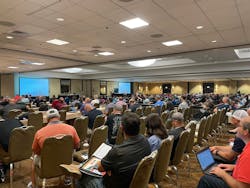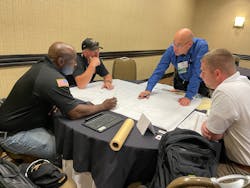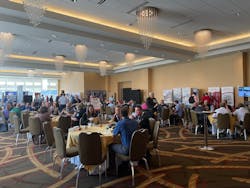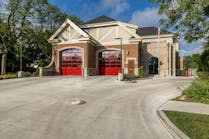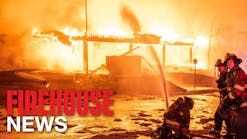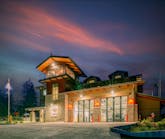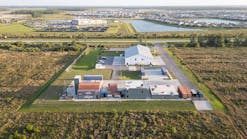Building a new fire station has changed significantly in the past several years, and the evolution seems destined to continue for the foreseeable future. Even building plans that were developed as recently as three years ago might need to be updated.
Since 2000, firefighting, EMS and law enforcement jobs are more dangerous. Viruses (H1N1, MRSA, COVID-19), civil unrest, natural and human-made disasters, and excessive stress on mental health are the main culprits. Therefore, decontamination zones, heightened security, increased training and shrinking budgets must be high on your priority list if you are going to build a firehouse.
The 2022 Station Design Conference, which will convene May 23–26 in Rosemont, IL, will include more than 30 programs that are tailored to help you to design the right facility for your department and the community that it serves. Conference presenters include fire chiefs and officers who are experienced with the development of new facilities as well as key executives of architectural firms that specialize in public safety facilities.
Getting started
The general session begins on May 24 with an overview of the process of designing and building a station or facility in 2022 and beyond. Kenneth Newell, AIA, of Stewart-Cooper-Newell Architects, will share his expertise in an effort to provide a solid foundation of knowledge on public safety facilities. His address undoubtedly will prepare you for the wide-ranging conference presentations that will follow.
Because starting a new project brings questions from the community and municipal leaders, numerous conference presentations will help to ready you to field those queries. For example, one session will spell out the benefits of investing in a study. Another will key on the fundamentals of creating a building program.
Sixteen classes on the afternoon of May 24 fall into four tracks. Two target fire stations, one focuses on law enforcement and a first-of-its-kind fourth track focuses on co-located facilities, EMS complexes and emergency operations centers (EOCs). Each of the tracks is open to all attendees.Stations & firefighter health
Perhaps the most significant change in fire station design involved the introduction in 2015 of the Hot/Warm/Cold zone concept, in an effort to reduce firefighters’ exposure to carcinogens in the firehouse.
“Designing for Exposure Reduction and Contaminant Control in Fire and EMS Facilities,” which will be delivered by Katie Atwater, AIA, and Christopher Kehde, AIA, of LeMay Erickson Willcox Architects, will present case studies and lessons learned from the creation of Hot, Warm and Cold Zones in new and renovated facilities, the development of which involved Atwater and Kehde’s agency. That includes the design of the new three-story Fire Station No. 33 for the city of Fairfax, VA, which, because of the constraints of a 0.95-acre site, required the dormitory areas (kitchen, dayroom, dining room, bunk rooms) to be located on a third level that spans the station’s apparatus bays.
FEMA-grant-sponsored research on firefighter physical and mental health in the past three years is the focus of several breakout sessions. Three of those sessions key on studies about sleep deprivation, an update on post-traumatic stress disorder and health-oriented design changes in the apparatus bay, respectively.
Combining to save costs
As local governments around the country tighten budgets, their need for suitable, secure public safety structures continues. Consequently, the incidence of multi-agency (fire, law enforcement, city hall, etc.) public safety facilities has increased.
James Stumbo, AIA, of Stewart-Cooper-Newell Architects, will follow up on his 2021 Station Design Conference presentation regarding options for significant savings by co-locating public safety facilities with “How to Plan and Design a Successful Shared Public Safety Facility.” This will include an explanation of how co-locating facilities serves to improve working relationships between fire and law enforcement.
The case study of the co-location of the Fridley, MN, Police Department and Fire Department, which was designed by BKV Group, is sure to prompt some ideas for attendees. The facility’s design, which received a Bronze Award in Firehouse Magazine’s 2019 Station Design Awards, includes a shared training room that can function as an EOC.
Cost savings possibilities also are covered in sessions that spring from fire department case studies that involve design standardization (prototypes)—whether to renovate or build new—as well as how to renovate a station while remaining operational.
Also returning this year is Susan Gantt, AIA, of Architects Design Group. Those who are familiar with Gantt’s thorough essay on the effects of climate change, including rising sea levels, ice storms, hurricanes and tornados, on firehouse design from 2020 might be surprised to learn that an update to that information already is necessary. Gantt will present “Designing Public Safety Facilities for Changing Climates.”
A related conference program will delve into the International Building Code for storm shelter requirements.EOCs & EMS
Natural and human-made disasters require EOCs to coordinate multiple agencies and community services. Feedback from attendees of the 2021 Station Design Conference included requests for presentations on EOCs. The organizers of 2022’s conference took that to heart.
If a new or upgraded EOC is your goal, Jannine Wilmoth, PhD, who is the emergency manager for the Anaheim, CA, Fire Department, will explain what’s necessary to move your plans forward, and Ray Holliday, AIA, of Brown Reynolds Watford Architects, will home in on the necessities for a smaller fire department EOC.
Attendees of the 2021 Station Design Conference also expressed interest in information about EMS facilities. Ask and you will receive, we say.
“Centralizing EMS Operations to Enhance Community Service” will be presented by Chief Kelly Cope of the St. Charles County Ambulance District in St. Peters, MO, and Roy Mangan, RA, of Archimages.
Return on investment
Don’t let your new fire station design be out of date before its built. Whether you are starting to contemplate a new facility or are knee-deep in a construction site, the 2022 Station Design Conference will show you how to save time, money and headaches on your new or renovated fire station or public safety facility. We promise.
1-on-One
One-Stop Shop
In addition to the educational presentations, the Station Design Conference provides an exhibit area. This year, more than 60 companies that specialize in services and products for public safety facilities will be on hand.
To maximize networking opportunities with these resources, breakfasts, lunches and breaks will be offered within the exhibit area.
Firehouse Staff
Content written and created by Firehouse Magazine editors.
